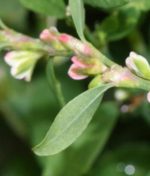 Common knotweed is an annual weed and a member of the buckwheat family, Polygonaceae, that also includes rhubarb, sorrel, and dock. It is native to Europe and Eurasia but was introduced to North America in colonial times and now occurs in all 50 states of the US except possibly California. Plants tolerate almost all soils in full sun and do well in sandy, gravelly, or rocky areas, grasslands, sidewalk edges, high traffic areas, roadsides, crevices, paths, paved areas, gardens, cultivated fields, and waste areas.
Common knotweed is an annual weed and a member of the buckwheat family, Polygonaceae, that also includes rhubarb, sorrel, and dock. It is native to Europe and Eurasia but was introduced to North America in colonial times and now occurs in all 50 states of the US except possibly California. Plants tolerate almost all soils in full sun and do well in sandy, gravelly, or rocky areas, grasslands, sidewalk edges, high traffic areas, roadsides, crevices, paths, paved areas, gardens, cultivated fields, and waste areas.
Description: This low growing weed has semi-erect wiry stems that grow four to sixteen inches high and hairless, short stalked leaves that are blue-green and oval but are variable. The joints of the stem are enclosed by a silvery, translucent, membranous sheath called an ochrea. Small apetalous flowers appear in the leaf axils from mid-summer to late fall and are green with white or pink margins. The fruit is a dark brown, three sided nut with a single seed that may be viable for up to fifty years but usually lasts no more than two. Plants spread by seed.
Control: Mulch to prevent seeds from germinating. Pull or hoe seedling as they appear and pull, cut or mow larger plants before they set seed. In severe case apply a preemergent herbicide. Post emergent herbicides are not as effective.